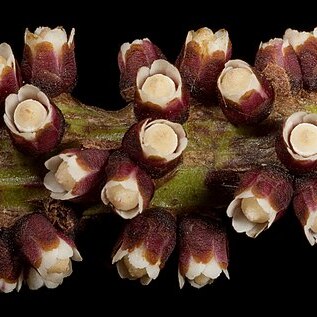Leaves reduced to imbricate bracts subtending flowers. Inflorescences solitary flowers produced endogenously and rupturing through host stems. Flowers with ringed nectary at base of sepals; sepals 4 or 5, free; stylar column expanded at apex into convex, knoblike disc, this sometimes fringed or papillose; staminate flowers with 1–3 series of anthers near column apex, under margin of disc; pistillate flowers with stigmatic areas in ring along or under margin of disc. Capsules irregularly dehiscent, perianth and column remaining essentially unchanged after flowering. Seeds 0.2–0.3 mm; embryos relatively undifferentiated.
Holoparasitic, living inside the stems of Fabaceae plants (hosts include several legume genera in Australia), producing flowers that burst through the surface tissue of the host. Flowers solitary, minute, globose, unisexual. Bracts imbricate, crowded, adnate at base to ovary and similar to perianth segments. Tepals 4–6, bract-like, distinct, imbricate, persistent. Anthers unilocular, dehiscing by a terminal pore. Ovary unilocular; placentas parietal. Fruit a berry. Seeds with reticulate testa.

